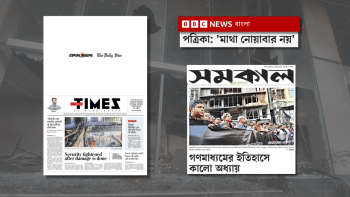River Korotoa: In peril for pollution

The Korotoa river in Bogra is nearly choking as the waters run low and pollutants are pumped in from the municipality sewerage and local industries.
The dissolved oxygen rate is three times below the recommended rate for seven to eight months a year, mostly during the dry seasons when the water flow dips further, according to monthly reports by the environmental office in Bogra.
The once-mighty Korotoa, that enters Bangladesh through the Rangpur district, runs 106 kilometres across Bogra.
A fisherman, Nityananda Das, 45, from Demazani (palpara) village under Shahjahanpur upazila, said, “There is no water and no fish in the waters anymore; how can we survive in this profession?
“In my early years, we used to catch a variety of fish from the river. But now there are only a few varieties, like Taki and Shoal,” he added.
According a report by Rural Development Academy (RDA) in Bogra, heavily-loaded vessels used to ply the waters of Korotoa almost 90 years ago.
Rishikesh Pall, a potter from Shahjahanpur upazila of Bogra, said, “When there was enough water to carry the big boats 25-30 years ago, traders used to come in and buy 30,000-40,000 pots of our stock. But now, sales are barely enough to sustain us as we have to sell our products by walking for miles.”
The Department of Environment (DoE), Rajshahi divisional office, Bogra, regularly examines water samples at eight points of the river. They have found alarmingly low rates of dissolved oxygen.
According to the water analysis report, the dissolved oxygen (DO) rate is only 2-3 mg per litre at Korotoa, while it is 6-7 mg in other rivers in Rajshahi division.
The rate of the dissolved oxygen in river water should ideally be at 4.5-8, as per the Environment Conservation Rules.
Moreover, the reports show some rate of chemical oxygen demand (COD) and a lack of biological oxygen demand (BOD), which jeopardises river water quality.

Md Masud Rana, a chemist at the Bogra environment office, said, “COD normally does not exist in river water, but in Korotoa, we get it regularly. A lack of sufficient oxygen and existing chemicals have a bad impact on the ecology of the river,” he said.
The report also shows that the water of Korotoa is acidic as it has a low pH of below 7. It is much higher in other rivers in Rajshahi division.
The suspended, colloidal and dissolved solids in a water sample from Korotoa (measured as total solid and total dissolved solids) are also comparatively higher, the report shows. It is 180-220 mg/l in Korotoa, while it is 60-180 mg/l in the other rivers in the region.
“Total solids (TS) can come from various types of runoff like fertilisers from agricultural lands, calcium carbonate, industrial waste, effluent from water treatment plants, etc. The high rate of TS can harm the biotic community, decrease the rate of photosynthesis and increase the temperature of the river water,” said Md Faruk Ahmed, assistant professor of the chemistry department of the Govt. Azizul Haque College, Bogra.
There are several small to midsized factories and clinics and hospitals along the banks of the river, which release harmful chemicals and waste into the water, said an official of the environment department in Rajshahi.
Most factories do not have effluent treatment plants (ETP) or environment clearance certificates and they are polluting Korotoa's waters, the official added. “Even, the Essential Drugs Company Limited (EDCL) that produces medicine for the government does not run the ETP properly. It has only one ETP to manage dry waste, but nothing for fluid waste.”
SM Ahsan, deputy general manager of EDCL, said, “We have one old ETP built in 1983 by Japanese engineers. We have already offered a tender to build a modern ETP.”
Md Ashrafuzzaman, director of the DoE, Rajshahi divisional office in Bogra, said, “We regularly collect water samples from the Korotoa, examine it and send a report to the Dhaka office. The industrial waste and the sewerage water flows into the Korotoa, and due to a lack of water flow, the old waste gathers on the river basin. Therefore, the oxygen level in the water is decreasing day by day,” the director added.
Md Hasan Mahmud, executive engineer of the water development board in Bogra, said, “Due to implementation of the Nurulla Beel project (1992-1996) and the Khulshi three vents regulator (flood control project) on downstream Korotoa in the Gobindaganj upazila, the water sources of the Korotoa was discarded and the silt basin rose by 5-7 feet for a stretch of almost 1.5-2 kilometres along the project.”

 For all latest news, follow The Daily Star's Google News channel.
For all latest news, follow The Daily Star's Google News channel. 



Comments